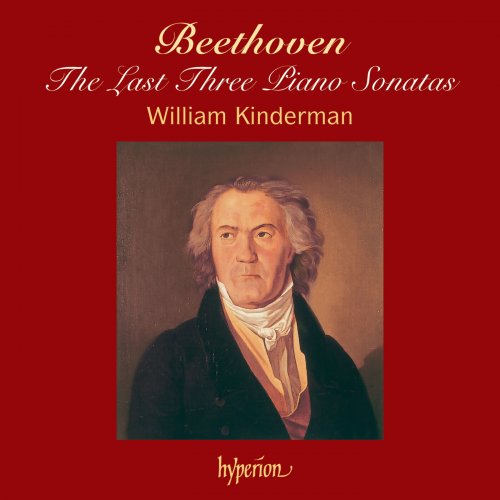
William Kinderman - Beethoven: Piano Sonatas, Op. 109, 110 & 111 (2002)
BAND/ARTIST: William Kinderman
- Title: Beethoven: Piano Sonatas, Op. 109, 110 & 111
- Year Of Release: 2002
- Label: Hyperion
- Genre: Classical Piano
- Quality: flac lossless (tracks) +Booklet
- Total Time: 01:07:04
- Total Size: 202 mb
- WebSite: Album Preview
Tracklist
01. Piano Sonata No. 30 in E Major, Op. 109: I. Vivace ma non troppo – Adagio espressivo –
02. Piano Sonata No. 30 in E Major, Op. 109: II. Prestissimo
03. Piano Sonata No. 30 in E Major, Op. 109: III. Andante molto cantabile ed espressivo. Gesangvoll mit innigster Empfindung
04. Piano Sonata No. 31 in A-Flat Major, Op. 110: I. Moderato cantabile molto espressivo
05. Piano Sonata No. 31 in A-Flat Major, Op. 110: II. Allegro molto
06. Piano Sonata No. 31 in A-Flat Major, Op. 110: III. Adagio ma non troppo – Fuga. Allegro ma non troppo
07. Piano Sonata No. 32 in C Minor, Op. 111: I. Maestoso – Allegro con brio ed appassionato
08. Piano Sonata No. 32 in C Minor, Op. 111: II. Arietta. Adagio molto semplice e cantabile
Beethoven was fifty. Though completely deaf, the ageing composer stood at the height of his creative powers. While rumours circulated that he was ‘written out’ since few of his pieces had recently been published, Beethoven was sketching several gigantic new works: the Missa Solemnis, the ‘Diabelli’ Variations, and the Ninth Symphony. Then, in the spring of 1820, he turned for the last time in his career to his favourite medium of the piano sonata. Between 1820 and 1822, he repeatedly set the Mass aside in order to write a trilogy of piano sonatas for the publisher Adolf Schlesinger, which became one of the outstanding achievements of Beethoven’s late style.
The compositional origins of the Sonata in E, Op 109, actually preceded his negotiations with Schlesinger. It was apparently another request, from the editor Friedrich Starke, that motivated Beethoven in April 1820 to write a ‘new little piece’ or bagatelle – this is what eventually became the Vivace ma non troppo of the sonata. Beethoven seems to have originally contemplated a new two-movement E minor Sonata (like his earlier sonata Op 90) with the independently conceived first movement. In the end, however, he integrated all three movements through a network of motivic and thematic relationships...
01. Piano Sonata No. 30 in E Major, Op. 109: I. Vivace ma non troppo – Adagio espressivo –
02. Piano Sonata No. 30 in E Major, Op. 109: II. Prestissimo
03. Piano Sonata No. 30 in E Major, Op. 109: III. Andante molto cantabile ed espressivo. Gesangvoll mit innigster Empfindung
04. Piano Sonata No. 31 in A-Flat Major, Op. 110: I. Moderato cantabile molto espressivo
05. Piano Sonata No. 31 in A-Flat Major, Op. 110: II. Allegro molto
06. Piano Sonata No. 31 in A-Flat Major, Op. 110: III. Adagio ma non troppo – Fuga. Allegro ma non troppo
07. Piano Sonata No. 32 in C Minor, Op. 111: I. Maestoso – Allegro con brio ed appassionato
08. Piano Sonata No. 32 in C Minor, Op. 111: II. Arietta. Adagio molto semplice e cantabile
Beethoven was fifty. Though completely deaf, the ageing composer stood at the height of his creative powers. While rumours circulated that he was ‘written out’ since few of his pieces had recently been published, Beethoven was sketching several gigantic new works: the Missa Solemnis, the ‘Diabelli’ Variations, and the Ninth Symphony. Then, in the spring of 1820, he turned for the last time in his career to his favourite medium of the piano sonata. Between 1820 and 1822, he repeatedly set the Mass aside in order to write a trilogy of piano sonatas for the publisher Adolf Schlesinger, which became one of the outstanding achievements of Beethoven’s late style.
The compositional origins of the Sonata in E, Op 109, actually preceded his negotiations with Schlesinger. It was apparently another request, from the editor Friedrich Starke, that motivated Beethoven in April 1820 to write a ‘new little piece’ or bagatelle – this is what eventually became the Vivace ma non troppo of the sonata. Beethoven seems to have originally contemplated a new two-movement E minor Sonata (like his earlier sonata Op 90) with the independently conceived first movement. In the end, however, he integrated all three movements through a network of motivic and thematic relationships...
As a ISRA.CLOUD's PREMIUM member you will have the following benefits:
- Unlimited high speed downloads
- Download directly without waiting time
- Unlimited parallel downloads
- Support for download accelerators
- No advertising
- Resume broken downloads


